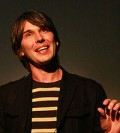Former D:Ream and Jimmy Page Band keyboardist Professor Brian Cox has been particularly excited about the Higgs boson’s discovery being confirmed.
After leaving the rock world, Cox turned to physics making a name for himself working at the world’s two largest atom-smashers: the Tevatron and the Large Hadron Collider. It was at the latter location that the illusive Higgs boson had been discovered, it was announced today.
Over Twitter, he announced the results saying: “So, in very simple language. ATLAS and CMS have independently discovered a new particle mass ~ 126 GeV which behaves like SM Higgs,” thus scientifically proving that musicians can be physicists too!
For those who are more scientifically literate, read on:
At a presentation at CERN in Geneva, spokespeople for both CMS and ATLAS detectors announced they have has confirmed that they have discovered a new Higgs-like particle.
The announcement was made via video-link to conference attendees of the International Conference on High Energy Physics (ICHEP) in Melbourne, Australia.
“We have observed a new boson with a mass of 125.3 +/- 0.6 GeV at 4.9 sigma significance,” said CMS spokesperson Joe Incandela’s final slide announced after around 45 minutes of explaining the data. He had mentioned earlier in the presentation that they had predicted 5.9 sigma, however 4.9 is still a spectacular result.
ATLAS spokesperson Fabiola Gianotti followed Incandela’s presentation with another cheer-drawing result: She simply presented a slide with a five-sigma result for a mass of 126.5 GeV which set the intercontinental audience into a frenzy.
“We have only recorded one-third of the data expected in 2012. This is just the beginning. There is more to come. Secondly, the LHC and the experiements are doing miracles. We are working beyond the design. Please, in particular theorists, be patient,” Gianotti half-joked during her presentation.
“It is very exciting that the Higgs boson is at this mass, because at this mass we can study it with this machine, so thanks nature!” she added.
Five-sigma is considered the benchmark for “confirming” results in experimental particle physics.
“These results are now global and shared by all of mankind,” a visibly ecstatic Joe Incandela said in reference to the enormous international collaboration that made this possible.
The hunt for the Higgs was one of the main objectives of both the CMS and ATLAS detectors at the Large Hadron Collider.
“As a layman I think we can say that we have it,” CERN directed R.D. Heuer said.
“It’s a historic day today,” Heuer continued. “But we are only at the beginning. There is a lot of work ahead of us. It has global implications for the future and it omes at the right time. I think we can be very very optimistic.”
Peter Higgs was present at the announcement. He told the experimentalists: “I would like to add my congratulations to everybody involved in this tremendous achievement. Really it is an incredible thing that has happened in my lifetime.”
So what is “the Higgs” and what does it do?
While much of the mainstream media tends focus on the particle itself, it might be easier to imagine the Higgs field to get an idea of what it actually does.
In quantum field theory, particles are considered to be small chunks of a field that permeates the entire universe. The Higgs field is what gives particles mass. The more massive (or weighty, for the purposes of this discussion) a particle is, the stronger the interaction between the particle and the field itself.
According to Einstein’s theory of special relativity, the ultimate speed limit in the universe is the speed of light. That’s quick. It’s really quick. In fact, it’s around 300,000 kilometres per second – or around seven and a half times around the equator every second. It’s also the speed at which particles with no mass will travel. These particles have no interaction with the Higgs field and are free to roam the universe at the maximum speed possible.
A particle that interacts with the field will be slowed down in a way somewhat analogous to how you would slow down when you run along the beach and hit the water. Imagine a more massive particle being more difficult to move. This is loosely how the Higgs can be imagined.
The particle is the (no longer) missing piece of the puzzle of the standard model of particle physics. The standard model provides the framework for particle physics. The messy-but-accurate theory pieces together different particles, grouping them into families.
Noise11’s Tim Cashmere will be at the ICHEP all week exercising his inner physics-nerd, covering all the announcements for the brand new science site Particle Schmarticle. You can follow them on Twitter and you can follow Tim on Twitter as well.














